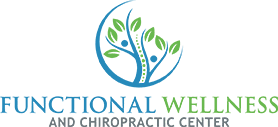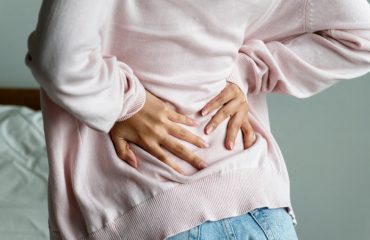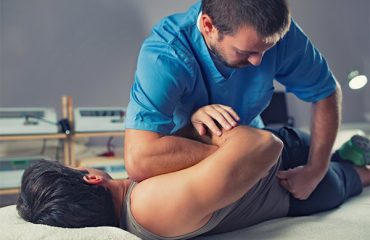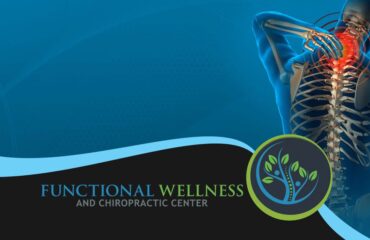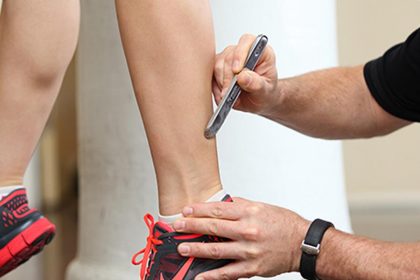
Soft tissue therapy is one form of therapy that gets utilized quite often in my clinic, which deals with any pain or dysfunction of muscle, ligaments, tendons, and/or fascia. The times I utilize soft tissue therapy is when there has been some overuse or trauma to a particular area and when there is still a tight/tender muscle, even after a chiropractic adjustment. There are many ways I deal with soft tissue in my clinic, which include trigger point therapy, muscle release techniques, proprioceptive neuromuscular facilitation (PNF), reciprocal inhibition, nerve flossing, and neuromuscular rehabilitation (NMR) to name a few. One technique that utilizes a few therapies and molds it into one concept to treat soft tissue dysfunction is Functional and Kinetic Treatment with Rehab (FAKTR).
FAKTR
FAKTR is a hierarchical system/concept of how to approach a patient and treat them based on severity, because sometimes the more severe soft tissue injuries cannot handle the more complex forms of treatment (there is also a pain tolerance factor as well). The system involves provocation of pain of the soft tissue (ranging from no motion and no mechanical load of the muscle, to motion without mechanical load, and motion with mechanical load) while utilizing kinesiology tape and Instrument Assisted Soft Tissue Massage (IASTM).
IASTM
IASTM is a big component of FAKTR, and it is exactly what it sounds like in which an instrument (surgical-steel tool with beveled edge) is used to massage the soft tissue to break up scar tissue and promote fibroblastic proliferation. Fibroblastic proliferation is the purpose of the IASTM, because when any soft tissue is injured that means that the integrity and alignment of fibers get ruined, and fibroblastic proliferation is necessary to heal the damaged tissue. When an injury occurs, the human body lays down tissue that is aligned in random directions, and eventually over time will align correctly through natural tensile and compressive forces with use of that particular soft tissue. IASTM is stimulus that will increase fibroblastic proliferation and align them, meaning that strong tissue is laid down more readily, and ultimately a quicker recovery from soft tissue injuries.
Stressors and New Tissue
One concept that was eluded to early deals with increase of new tissue being laid down as a response to a stressor (FAKTR is a controlled stressor). Stressors (exercise/rehab) are the tensile and compressive forces that makes the body lay down new tissue at an increased rate as a compensation to deal with those tensile and compressive forces. After the inflammatory phase (within 72 hours) of an injury, the body immediately starts to lay down new tissue to repair and heal the damaged tissue. That is why it is important to stress the tissue in a controlled way to promote healing, rather than resting the soft tissue. Resting a soft tissue injury has been shown to delay and inhibit full recovery.
One big thing to keep in mind about the stressors is that it should NOT be painful, because that means that the tissue is getting damaged. For example: after 72 hours of a sprained ankle, the person should put enough weight on their ankle to the point where it doesn’t hurt. If full body weight causes pain on the ankle, then crutches should be utilized to distribute weight some of the weight off the ankle so there isn’t any pain. Utilizing FAKTR on injured tissue can be painful, but it is a controlled stressor which will promote healing rather than further damage. Back to the ankle example: the fibularis (peroneal) muscles will most likely hurt during FAKTR, because it is the actual massaging of the muscle that is painful.
The massage is the controlled stressor that will stimulate the body to lay down tissue for healing for the fibularis muscles (as well as other tissues that were massaged).
Conditions that Respond Well
Generally, the conditions that respond excellent to FAKTR include: ligament sprains, muscle strains, tendonopathies, bursitis, fascial syndromes, edema reduction, nerve entrapement syndromes, delayed onset muscle soreness, and scar tissue/adhesions. Just like anything else in the healthcare field, there are contraindications to FAKTR, that is why it is important to go to a FAKTR certified practitioner. With all that being said, the majority of soft tissues should fully recover and return to a normal state when properly treated. Proper treatment for any soft tissue injuries require nutritional interventions as well.
About Dr. Eric Johnson
Dr. Eric Johnson, Doctor of Chiropractic and Diplomate of the American Clinical Board of Nutrition as well as owner of Functional Wellness and Chiropractic Center in Madison, WI, is a functional medicine doctor that identifies root causes of pain and/or dysfunction. His systems-based, not symptoms-based, approach is a comprehensive, holistic approach that helps identify mental, chemical, and physical stressors that are underlying numerous health conditions. If you are in the Madison, Middleton, Verona, Waunakee area and looking to not only feel better, but live better, contact Dr. Eric at (608) 203-9272.
References
Alfredson H, Pietila T, Jonsson P, and Lorentzon R. Heavy-load eccentric calf muscle training for the treatment of chronic Achilles tendinosis. Am J Sports Med. 1998 May-Jun; 26(3): 360-366.
Bayer ML. Early versus delayed rehabilitation after acute muscle injury. N Engl J Med. 2017 Sep 28; 377: 1300-1301. http://www.nejm.org/doi/full/10.1056/NEJMc1708134
Benjamin M. The fascia of the limbs and back-a review. J Anat. 2009 Jan; 214(1): 1-18.
Bove GM, Harris MY, Zhao H, and Barbe MF. Manual therapy as an effective treatment for fibrosis in a rat model of upper extremity overuse injury. J Neurol Sci. 2016 Feb 15; 361: 168-180.
Casell C. Tensile force in total striated muscle, isolated fiber and sarcolemma. Acta Physiol Scand. 1950 Dec; 21(4): 380-401.
Candiani G, Riboldi SA, Sadr N, Lorenzoni S, Neuenschwander P, Montevecchi FM, and Mantero S. Cyclic mechanical stimulation favors myosin heavy chain accumulation in engineered skeletal muscle constructs. J Appl Biomater Biomech. 2010 May-Aug; 8(2): 68-75.
Cezar CA, Roche ET, Vandenburgh HH, Duda GN, Walsh CJ, and Mooney DJ. Biologic-free mechanically induced muscle regeneration. P Natl Acad Sci USA. 2016 Feb; 113(6): 1534-1539.
Deising S, Weinkauf B, Blunk J, Obreja O, Schmelz M, Rukwied R. NGF-evoked sensitization of muscle fascia nociceptors in humans. Pain. 2012 Aug; 153(8): 1673-1679.
Eagan TS, Meltzer KR, and Standley PR. Importance of strain direction in regulating human fibroblast proliferation and cytokine secretion: a useful in vitro model for soft tissue injury and manual medicine treatments. J Manipulative Physiol Ther. 2007 Oct; 30(8): 584-592.
Gaby A. Nutritional Medicine. Fritz Perlberg Publishing. 2011.
Gehlsen GM, Ganion LR, and Helfst R. Fibroblast responses to variation in soft tissue mobilization pressure. Med Sci Sports Exerc. 1999 Apr; 31(4): 531-535.
Goetsch KP, Snyman C, Myburgh KH, and Niesler CU. Simultaneous isolation of enriched myoblasts and fibroblasts for migration analysis within a novel co-culture assay. Biotechniques. 2015 Jan 1; 58(1): 25-32.
Hoheisel U and Mense S. Inflammation of the thoracolumbar fascia excites and sensitizes rat dorsal horn neurons. Eur J Pain. 2015 Mar; 19(3): 419-428.
Jonsson P and Alredson H. Superior results with eccentric compared to concentric quadriceps training in patients with jumper’s knee: a prospective randomized study. Br J Sports Med. 2005 Nov; 39(11): 847-850.
Joshi SD, Yogesh AS, Mittal PS, and Joshi SS. Morphology of the bicipital aponeurosis: a cadaveric study. Folia Morphol (Warsz). 2014 Feb; 73(1): 79-83.
Langevin HM, Churchill DL, and Cipolla MJ. Mechanical signaling through connective tissue: a mechanism for the therapeutic effect of acupuncture. FASEB J. 2001 Oct; 15(12): 2275-2282.
Langevin HM, Churchill DL, Wu J, Badger GJ, Yandow JA, Fox JR, Krag MH. Evidence of connective tissue involvement in acupuncture. FASEB J. 2002 Jun; 16(8): 872-874.
Langevin HM and Sherman KJ. Pathophysiologcial model for chronic low back pain integrating connective tissue and nervous system mechanisms. Med Hypotheses. 2007; 68(1): 74-80.
Loghmani MT and Warden SJ. Instrument-assisted cross-fiber massage accelerates knee ligament healing. J Orthop Sports Phys Ther. 2009 Jul; 39(7): 506-514.
Loghami MT and Warden SJ. Instrument-assisted cross fiber massage increases tissue perfusion and alters microvascular morphology in the vicinity of healing knee ligaments. BMC Complem Altern M. 2013; 13: 240.
Kim J, Sung DJ, and Lee J. Therapeutic effectiveness of instrument-assisted soft tissue mobilization for soft tissue injury: mechanisms and practical application. J Exerc Rehabil. 2017 Feb; 13(1): 12-22. https://www.ncbi.nlm.nih.gov/pmc/articles/PMC5331993/
Komi PV and Buskirk ER. Effect of eccentric and concentric muscle condition on tension and electrical activity of human muscle. Ergonomics. 1972 Jul; 15(4): 417-434.
Mafi N, Lorentzon R, and Alfredson H. Superior short-term results with eccentric calf muscle training compared to concentric training in a randomized prospective multicenter study on patients with chronic Achilles tendinosis. Knee Surg Sports Traumatol Arthrosc. 2001; 9(1): 42-47.
Page P. A new exercise for tennis elbow that works! N Am J Sports Phys Ther. 2010 Sep; 5(3): 189-193.
Pavan PG, Stecco A, Stern R, and Stecco C. Painful connections: densification versus fibrosis of fascia. Curr Pain Headache Rep. 2014; 18(8): 441.
Ramsey RW and Street SF. The isometric length-tension diagram of isolated skeletal muscle fibers of the frog. J Cell Phys. 1940 Feb; 15(1): 11-34.
Stanish WD, Rubinovich RM, and Curwin S. Eccentric exercise in chronic tendinitis. Clin Orthop Relat Res. 1986 Jul; (208): 65-68.
Stecco A, Macchi V, Stecco C, Porzionato A, Ann Day J, Delmas V, De Caro R. Anatomical study of myofascial continuity in the anterior region of the upper limb. J Bodyw Mov Ther. 2009 Jan; 13(1): 53-62.
Toyoda T, Saito S, Inokuchi S, and Yabe Y. The effects of tensile load on the metabolism of cultured chondrocytes. Clin Orthop Relat Res. 1999 Feb; (359): 221-228.
Troup JDG and Videman T. Inactivity and the aetiopathogenesis of musculoskeletal disorders. Clin Biomech. 1989 Aug; 4(3): 173-178.
Tyler TF, Thomas GC, and Nicholas SJ, and McHugh MP. Addition of isolated wrist extensor eccentric exercise to standard treatment for chronic lateral epicondylosis: a prospective randomized trial. J Shoulder Elbow Surg. 2010 Sep; 19(6): 917-922.
Wilke J, Krause F, Vogt L, and Banzer W. What is evidence-based about myofascial chains: a systematic review. Arch Phys Med Rehabil. 2016 Mar; 97(3): 454-461.
Willard FH, Vleeming A, Schuenke MD, Danneels L, and Schleip R. The thoracolumbar fascia: anatomy, function and clinical considerations. J Anat. 2012 Dec; 221(6): 507-536.
